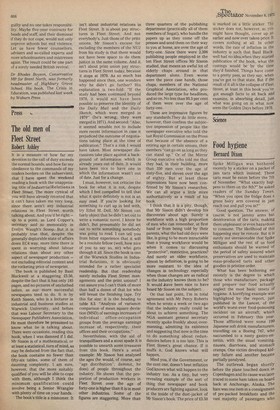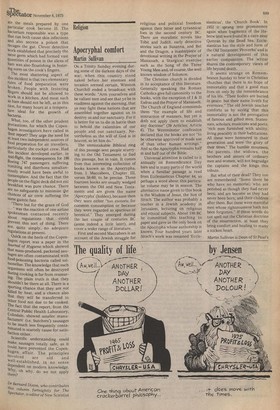Science
Food hygiene
Bernard Dixon
Spike Milligan was bothered recently by a sticker on a packet of jam tarts which insisted: These tarts must be eaten before the 7th of November. "What exactly happens to them on the 8th?" he asked readers of the Sunday Times, "When you open the fridge does a green hairy arm covered in jam reach out and pull you in?"
Good question. The answer, of course, is not jammy arms but deterioration of the tarts, making them unpleasant or even hazardous to consume. The likelihood of this happening may be remote. But it is surely not unreasonable that Spike Milligan and the rest of us food enthusiasts should be warned of the period of safety assured when preservatives are used to maintain mass-produced tarts and other goodies in pristine order.
What has been bothering me recently is the degree to which those who manufacture, package and prepare our food actually neglect the most basic tenets of hygiene. A horrifying example was highlighted by the report, just published in the Lancet, of the world's worst-ever food-poisoning incident on an aircraft, which occurred in February this year. Those afflicted were some 190 Japanese soft drink manufacturers, travelling on a Boeing 747, who succumbed to a nasty gastro-enteritis, with the usual vomiting, nausea, diarrhoea, and stomach cramps. One victim developed kidney failure and another became partially.paralysed.
The outbreak began shortly before the plane touched down in Copenhagen and its cause was later traced to some ham taken on board back at Anchorage, Alaska. The ham was one item in a consignment of pre-packed breakfasts and the vast majority of passengers who ate the meals prepared by one particular cook became ill. The bacterium responsible was a type that can both cause skin infections and also secrete a poison that ravages the gut. Clever detective Work established that precisely the same germ which had formed vast quantities of poison in the slices of ham was also flourishing in festering sores on the cook's fingers. The most shattering aspect of this incident is that two elementary rules of food preparation were broken. People with festering fingers should not be allowed to Work in a kitchen. And meat such as ham should not be left, as in this case, for many hours at a temperature ideal for the growth of bacteria.
What, too, of the other pradent precautions, for which the Copenhagen investigators have called in their report? They urge the need for at least two independent sources of food preparation for air travellers, Particularly the cockpit crew. Had this incident developed earlier, in mid-flight, the consequences for 190 Boeing 747 passengers suffering vomiting and diarrhoea simultaneously Would have been awful to Contemplate. And the fact that the People on the flight deck did not eat breakfast was pure chance. There are no safeguards to minimise %he Chances of air crew suffering the same gastric fate.
"There but for the grace of God ' • • " Was the reaction of one airline spokesman contacted recently about regulations that could Prevent this sort of thing. There are, quite simply, no adequate regulations at present. Quick on the heels of the Copenhagen report was a paper in the Journal of Hygiene which showed that mass-produeed, packeted sausages are often contaminated with food-poisoning bacteria called salmonellae. The knowledge that such organisms will often be destroyed during cooking is far from reassuring. The plain truth is that they Shouldn't be there at all. There is a Sporting chance that they are not killed by heat, and a chance also that they will be transferred to Other food not due to be cooked. The fact that the report, from the Central Public Health Laboratory, Colindale, showed smaller manufacturers' (i.e. butchers') sausages to be much less frequently contarninated is scarcely cause for satisfaction either.
Scientific understanding could Make sausages totally safe, as it could have prevented the Copenhagen affair. The principles
involved are old and well-established, in no sense dependent on modern knowledge.
Why, oh why, do we not apply them?
Dr Bernard Dixon, who contributes this column fortnightly for The Spectator, is editor of New Scientist

































 Previous page
Previous page